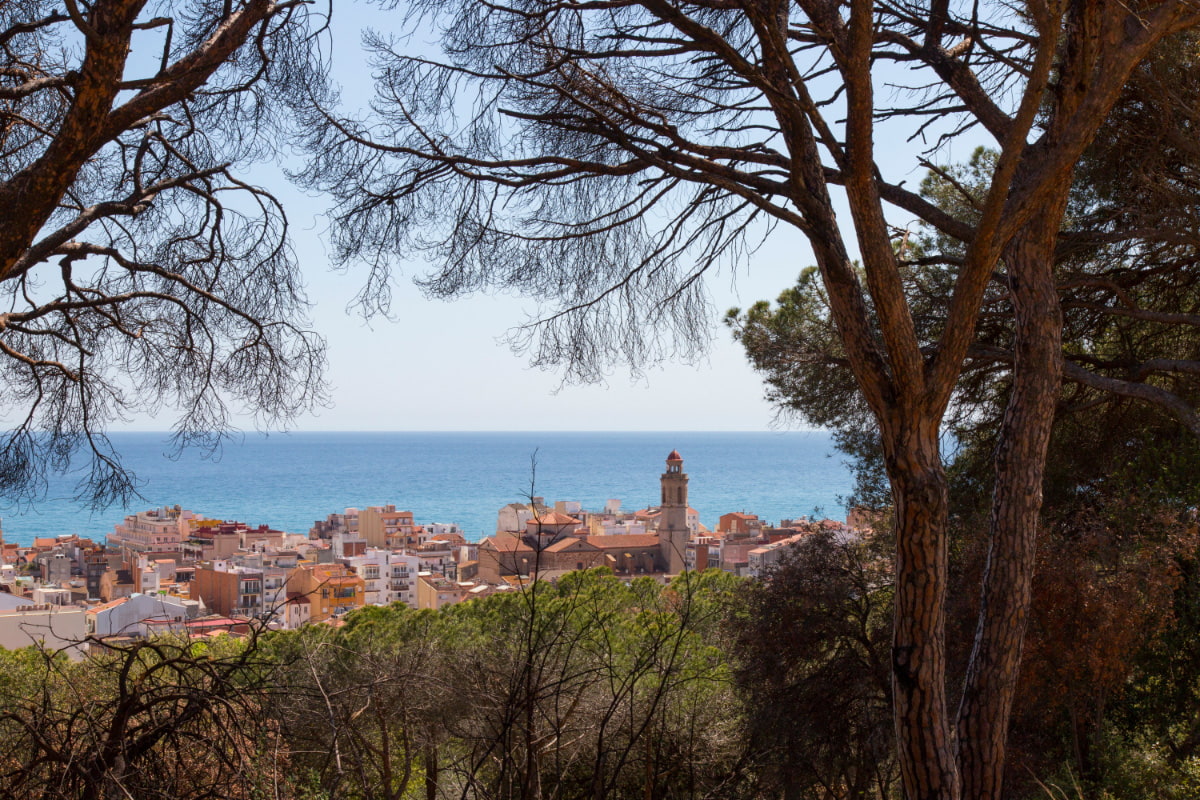Explore the coastal history of Calella

Calella: where history meets the Mediterranean
Long before becoming a tourist destination, Calella was already a strategic hub for fishermen, merchants, and coastal lookouts. Strolling through its narrow streets or gazing out from the cliffs is like walking through five centuries of connection between sea and mountains. This guide will lead you to the town’s most iconic monuments, museums, and traditional spots that give Calella its unique character as capital of the Maresme Coast.
Must-see landmarks in Calella

Calella Lighthouse
Built in 1859, the lighthouse lights up the coastline with a range of 35 kilometers. It’s not just a spectacular viewpoint—it also houses an exhibition on maritime signals and the evolution of lighthouses in Catalonia. You can walk there from Hotel Internacional in 25 minutes. Visit at sunset for an unforgettable panorama.
Las Torretas
On the same cliff, you’ll find the 19th-century telegraph towers that once connected Barcelona and Girona via optical signals. The ruins evoke a time of cutting-edge communication and offer one of Calella’s best photo spots today.
Church of Santa Maria and Sant Nicolau
Located in the heart of the old town, this 18th-century Baroque church features gold-leaf altarpieces and Neoclassical frescoes. Don’t miss the barrel-vault ceiling and the historic organ, which is still played during summer concerts.
Municipal Market
Opened in 1927, the market reflects the region’s Modernist style. Its iron structure and stained glass windows cast soft light on stalls filled with fresh fish and produce. Visit early to sample salted anchovies and artisanal cheeses.

Museums that tell Calella’s maritime story
Municipal Museum and Archive Josep M. Codina i Bagué
Housed in a former textile factory, this museum includes archaeology, ethnography, and art collections. Highlights include scale-model fishing boats and netting tools that illustrate the transition from sail to motor in local fishing fleets.
Tourism Museum (MUTUR)
The world’s first museum dedicated to the history of tourism. Interactive panels and audiovisuals show how Calella evolved from a fishing village into a major holiday destination during the 1960s tourism boom.
Dalmau Park Air Raid Shelter
Excavated in 1937 during the Spanish Civil War, this shelter protected locals from aerial bombings. Walking through its softly lit tunnels is a moving experience that connects visitors with the town’s civil resilience and collective memory.
Traditional districts and hidden corners
Carrer de l’Església
This pedestrian shopping street preserves its white façades, wrought iron balconies, and cobblestone paving. At night, the lamplight creates a romantic setting—perfect for tasting coca de llardons (pork crackling pastry) from century-old bakeries.
Fishermen’s Quarter
Between the beach and the railway line, you’ll find pastel-colored houses with oars hanging on doors and nets being repaired in quiet courtyards. Every June, this area hosts the Festa de la Mare de Déu del Carme, a seafaring procession honoring those who live from the sea.
Dalmau Park
This green oasis was inaugurated in 1928 and features towering pine trees and red earth paths. It was a favorite summer spot for Barcelona families arriving on steam trains. Don’t miss the Glorieta, a semicircular viewpoint that frames the Mediterranean through the treetops.

Self-guided routes to capture the local spirit
2-Hour Walk Through the Historic Center
- Start at the Church Square and visit the church.
- Stroll along Carrer de les Basses, once a guild district.
- Stop at Can Saleta, a fine example of colonial-style architecture.
- Enjoy a homemade vermouth at Bodega Queralt.
"Sea and Mountain" Route
- Morning hike to the Lighthouse and Las Torretas.
- Descent to the fishermen’s quarter for a traditional suquet de peix (Catalan fish stew).
- Evening walk along Manuel Puigvert promenade under the century-old trees.

Logistics Tips from Hotel Internacional
- Rent a bike for a comfortable and eco-friendly way to get around.
- Ask for the free historical map—it includes QR codes for audio guides.
- Buy a combo ticket for the Municipal Museum and Air Raid Shelter to save time and 15% off the total price.
- Wear closed-toe shoes for the lighthouse trails—the rocks can be slippery when misty.
Frequently Asked Questions
The first Sunday of every month, MUTUR and the Municipal Museum offer free entry. Arrive early, as capacity is limited.




